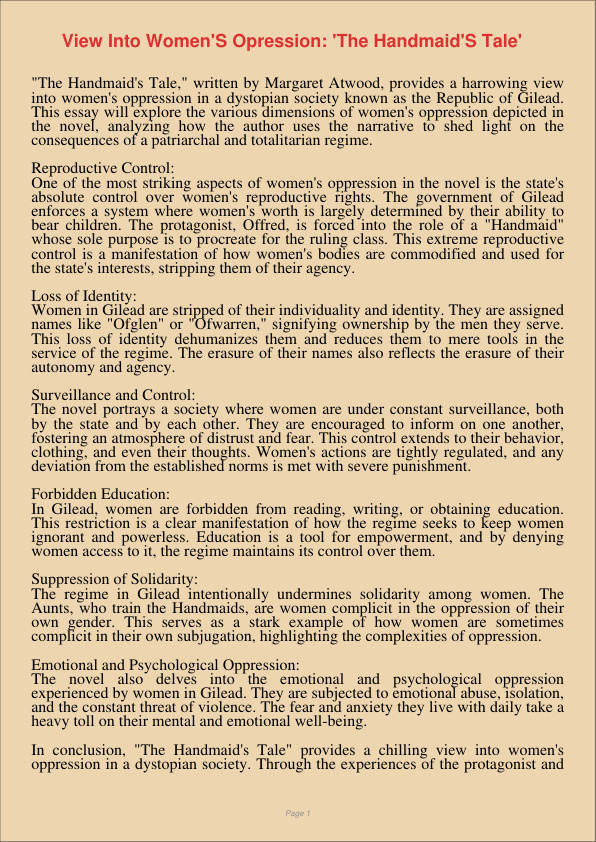View Into WomenS Opression The HandmaidS Tale
Jan 9, 2024
women
view
Information Technology
History

“The Handmaid’s Tale,” written by Margaret Atwood, provides a harrowing view into women’s oppression in a dystopian society known as the Republic of Gilead. This essay will explore the various dimensions of women’s oppression depicted in the novel, analyzing how the author uses the narrative to shed light on the consequences of a patriarchal and totalitarian regime.
Reproductive Control: One of the most striking aspects of women’s oppression in the novel is the state’s absolute control over women’s reproductive rights. The government of Gilead enforces a system where women’s worth is largely determined by their ability to bear children. The protagonist, Offred, is forced into the role of a “Handmaid” whose sole purpose is to procreate for the ruling class. This extreme reproductive control is a manifestation of how women’s bodies are commodified and used for the state’s interests, stripping them of their agency.
Loss of Identity: Women in Gilead are stripped of their individuality and identity. They are assigned names like “Ofglen” or “Ofwarren,” signifying ownership by the men they serve. This loss of identity dehumanizes them and reduces them to mere tools in the service of the regime. The erasure of their names also reflects the erasure of their autonomy and agency.
Surveillance and Control: The novel portrays a society where women are under constant surveillance, both by the state and by each other. They are encouraged to inform on one another, fostering an atmosphere of distrust and fear. This control extends to their behavior, clothing, and even their thoughts. Women’s actions are tightly regulated, and any deviation from the established norms is met with severe punishment.
Forbidden Education: In Gilead, women are forbidden from reading, writing, or obtaining education. This restriction is a clear manifestation of how the regime seeks to keep women ignorant and powerless. Education is a tool for empowerment, and by denying women access to it, the regime maintains its control over them.
Suppression of Solidarity: The regime in Gilead intentionally undermines solidarity among women. The Aunts, who train the Handmaids, are women complicit in the oppression of their own gender. This serves as a stark example of how women are sometimes complicit in their own subjugation, highlighting the complexities of oppression.
Emotional and Psychological Oppression: The novel also delves into the emotional and psychological oppression experienced by women in Gilead. They are subjected to emotional abuse, isolation, and the constant threat of violence. The fear and anxiety they live with daily take a heavy toll on their mental and emotional well-being.
In conclusion, “The Handmaid’s Tale” provides a chilling view into women’s oppression in a dystopian society. Through the experiences of the protagonist and other female characters, the author highlights the various forms of oppression that women can face in a patriarchal and totalitarian regime. The novel serves as a powerful cautionary tale, urging readers to reflect on the importance of safeguarding women’s rights and autonomy in the real world.